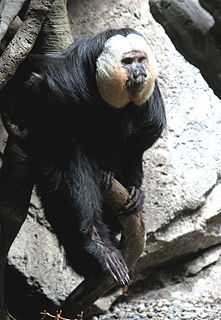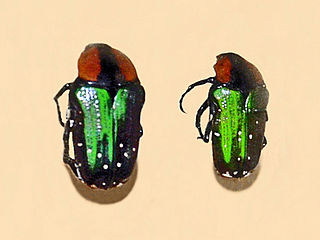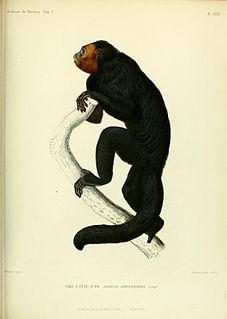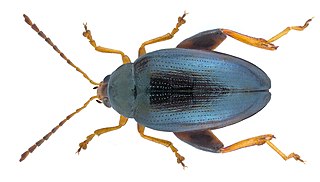Related Research Articles
Choricius, of Gaza (Greek: Χορίκιος, Greek sophist and rhetorician, flourished in the time of Anastasius I.

The Pitheciidae are one of the five families of New World monkeys now recognised. Formerly, they were included in the family Atelidae. The family includes the titis, saki monkeys and uakaris. Most species are native to the Amazon region of Brazil, with some being found from Colombia in the north to Bolivia in the south.

Sakis, or saki monkeys, are any of several New World monkeys of the genus Pithecia. They are closely related to the bearded sakis of genus Chiropotes.

Pitheciinae is a subfamily of the New World monkey family Pitheciidae. It contains three genera and 14 species. Pitheciines are forest dwellers from northern and central South America, east of the Andes.

Alaşehir, in Antiquity and the Middle Ages known as Philadelphia, is a town and district of Manisa Province in the Aegean region of Turkey. It is situated in the valley of the Kuzuçay, at the foot of the Bozdağ Mountain. The town is connected to İzmir by a 105 km (65 mi) railway. The longtime mayor is Gökhan Karaçoban.

Chaenotheca is a genus of lichenized fungi within the family Coniocybaceae. The sexual reproduction structures are a mass of loose ascospores that are enclosed by a cup shaped exciple sitting on top of a tiny stalk, having the appearance of a dressmaker's pin, hence the common name pin lichen. Genus members are also commonly called needle lichens.

The white-faced saki, called the Guianan saki and the golden-faced saki, is a species of the New World saki monkey. They can be found in Brazil, French Guiana, Guyana, Suriname and Venezuela. This species lives in the understory and lower canopy of the forest, feeding mostly on fruits, nuts, seeds, and insects. Although they are arboreal creatures and are specialists of swinging from tree to tree (brachiation), they are also terrestrial when foraging. White-faced sakis typically live around 14 years in their natural habitat and have been recorded to live up to 36 years in captivity. Sakis are active in the day and sleep highly elevated (15-20m) in trees with many leaves to shelter them from weather and flying predators.

Cancrinia is a genus of flowering plants in the aster family, Asteraceae. They are native to central Asia, where they are distributed in China, Mongolia, and Russia.
The Metropolis of Philadelphia was an ecclesiastical territory (diocese) of the Ecumenical Patriarchate of Constantinople in western Asia Minor, modern Turkey. Christianity in the city of Philadelphia, was introduced before the middle of the 1st century AD. Today the Metropolis of Philadelphia is the see of a titular Orthodox metropolitan.
Tachina chaetaria is a species of fly in the genus Tachina of the family Tachinidae that is endemic to South America.
Tropidema chrysocephala is a species of beetle in the family Cerambycidae, and the only species in the genus Tropidema. It was described by Charles Coquerel in 1851.
Mimotropidema is a genus of longhorn beetles of the subfamily Lamiinae, containing the following species:

Leucocelis is a genus of chafer beetles belonging to the family Scarabaeidae.

The golden-faced saki is a species of saki monkey, a type of New World monkey. It is found in Brazil north of the Amazon, on both sides of the Rio Negro. This species was formerly considered a subspecies of the white-faced saki, but was raised to full species status in 2014. The species is named for the coloration of the male, which has black body hair but orange or red-brown facial hair. The female has lighter body color and more bare skin on the face, with lines of orange hair extending down from below the eyes around the snout, as well as orange ventral fur.

Acacia biflora, commonly known as two-flowered acacia, is a shrub belonging to the genus Acacia and the subgenus Phyllodineae.

Acacia chrysocephala is a shrub belonging to the genus Acacia and the subgenus Phyllodineae.

Psylliodes is a large genus of flea beetles in the family Chrysomelidae. There are about 200 described species worldwide.
Mimotropidema nigerrima is a species of beetle in the family Cerambycidae. It was described by Stephan von Breuning in 1964.

Psylliodes chrysocephala or Psylliodes chrysocephalus, commonly known as the cabbage-stem flea beetle, is a species of leaf beetle situated in the subfamily Galerucinae and the tribe Alticini.
Cazuza's saki is a species of saki monkey, a type of New World monkey. It is endemic to northwestern Brazil.
References
- ↑ BioLib.cz - Mimotropidema chrysocephala. Retrieved on 8 September 2014.